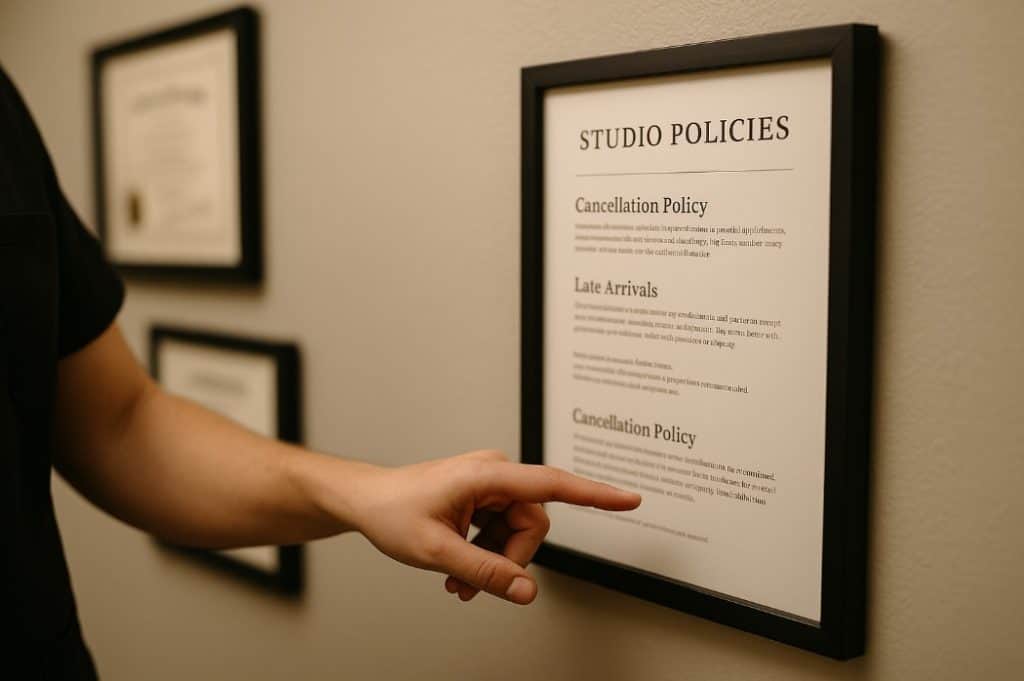
The client who texts at 10 PM wanting a same-day appointment. The regular who always runs 20 minutes over. The friend who expects a "quick shoulder rub" for free.
Sound familiar?
If you're a massage therapist who cringes at these scenarios, you're not alone. Many bodyworkers struggle with setting professional boundaries and charging what they're worth. But here's the uncomfortable truth: without clear boundaries and appropriate pricing, even the most skilled therapists burn out, feel resentful, and eventually leave the profession they love.
Professional boundaries and fair pricing aren't selfish. They're essential for creating a sustainable practice that serves clients well while supporting the life you deserve. This guide will show you exactly how to set, communicate, and maintain the boundaries that transform a draining practice into a thriving business.
Massage therapy is inherently intimate work. Clients are vulnerable, often partially undressed, sharing their pain and stress. This intimacy makes professional boundaries even more critical than in other services.
Without clear limits, the therapeutic relationship becomes muddy. Clients may mistake professional care for personal friendship. They might feel entitled to your time outside scheduled appointments. Some push for discounts or free work. Others share traumatic stories that leave you emotionally drained.
Strong boundaries actually improve client relationships. When expectations are clear, clients feel safer. They understand the professional nature of the work. They respect your time and expertise. And paradoxically, they often become more loyal when they can't take advantage of you.
The connection between boundaries and income is direct. Therapists with poor boundaries typically undercharge, overwork, and burn out. Those with professional limits charge appropriately, work sustainably, and build long-term success.
Massage therapists face unique boundary tests:
Time boundaries plague many practitioners. Late arrivals expect full sessions. Sessions creep past scheduled end times. Clients text at all hours expecting immediate responses. "Just 10 more minutes on my shoulders" becomes 20.
Physical boundaries require constant vigilance. Inappropriate requests range from subtle to shocking. Some clients test draping limits. Others make uncomfortable comments about your appearance or touch.
Emotional boundaries blur when clients trauma-dump during sessions. You become an unofficial therapist, absorbing stories of divorce, death, and dysfunction while trying to focus on bodywork.
Financial boundaries crumble under sob stories and friendship requests. Everyone wants a deal. Long-term clients expect prices from five years ago. Friends assume "mates rates" mean free.
Professional boundaries stretch when clients seek medical advice, diagnosis, or treatment beyond your scope. "What do you think this lump is?" puts you in an impossible position.
Pro Tip
When a boundary feels uncomfortable to enforce, that's usually a sign it's the most important one to hold. The discomfort you feel saying "no" is temporary. The resentment from saying "yes" against your better judgment lingers far longer.

Your time has value. Start by setting real office hours and keeping them. If you work Tuesday through Saturday, 10 AM to 6 PM, then Monday doesn't exist for clients. Neither does 8 PM on Wednesday.
Build buffer time between clients. Fifteen to thirty minutes allows for proper room turnover, bathroom breaks, and mental reset. Rushed transitions serve no one well.
Late arrival policies protect your schedule and other clients. "Sessions begin and end at scheduled times" means a client 20 minutes late receives 40 minutes of work, not 60. No exceptions, no guilt.
Some therapists find success with strict policies: more than 15 minutes late equals a cancellation with full charge. Others offer the remaining time. Choose what works, communicate clearly, and stick to it.
Chronically late clients disrespect your time and stress your schedule. After three late arrivals, it's time for a conversation. If behavior doesn't change, it's time to part ways. Your practice doesn't need the chaos.
Technology makes everyone accessible 24/7, but you don't have to be. Professional response times train client behavior. Respond to texts and calls during business hours only. Use scheduling software as a buffer—clients book online instead of texting requests.
Set up auto-responses that establish expectations: "Thanks for your message. I return calls and texts Tuesday-Saturday between 10 AM and 6 PM. For immediate booking needs, please use my online scheduler at [link]."
Emergency versus convenience is crucial distinction. A true emergency? They'll go to the ER, not text their massage therapist. Everything else can wait until business hours.
"No" is a complete sentence, but having scripts helps:
"I'm not available for same-day bookings. My earliest opening is [date]."
"My schedule is set for work-life balance. I can see you during my regular hours on [day]."
"I maintain a 24-hour booking policy to ensure I'm fully present for each client."
Always offer alternatives without breaking boundaries. Can't see them today? Offer your next available slot. Can't work Sundays? Suggest your Monday morning opening.
Scope of practice isn't just legal protection—it's a boundary tool. When clients ask medical questions, redirect professionally:
"That's outside my scope of practice. I'd recommend consulting your doctor about that."
"I work with soft tissue, but I can't diagnose conditions. Your physician would be the right person to ask."
Friendship requests complicate therapeutic relationships. Keep it professional: "I value our therapeutic relationship too much to blur those lines. I keep my personal and professional lives separate."
Clear draping policies posted and verbally explained protect everyone. "I use professional draping throughout the session for your comfort and mine. The only exposed area is the part being worked on."
Inappropriate comments or requests end immediately. "That's not appropriate. This session is over." Document everything. Your safety and professional standards matter more than their feelings.
You always have the right to end sessions. Trust your gut. If something feels wrong, it probably is. "I don't think I'm the right therapist for your needs" is perfectly acceptable.
Emotional dumping drains therapists. Redirect gently: "That sounds really difficult. Have you considered talking to a counselor who specializes in that?"
For trauma oversharing: "I want to focus on helping your body feel better. Let's take some deep breaths together."
Maintain therapeutic distance without being cold. Care about clients without taking on their problems. Their stress is not your stress.

The caregiver mentality runs deep. Many therapists feel guilty charging for healing work. But grocery stores don't accept good intentions as payment. Your skill has value.
Fear of losing clients keeps prices artificially low. Here's the truth: clients who only come for cheap massage aren't your ideal clients anyway. Quality clients pay for quality work.
Imposter syndrome whispers you're not worth more. But consider your training hours, continuing education, and experience. You're a skilled professional, not a hobbyist.
Comparing to chain massage prices creates false equivalence. Those businesses operate on volume with therapist burnout. You offer personalized, therapeutic work. Different service, different price.
Let's get real about costs:
Monthly Expenses:
Hidden Time Costs:
The Expertise Factor:
When you calculate true costs plus expertise value, that $60 massage barely breaks even.
Key Takeaway
A 60-minute massage isn't 60 minutes of work. Factor in setup, breakdown, laundry, notes, and admin time, and each appointment consumes closer to 90 minutes. Price for the full commitment, not just table time.
Research local market rates, but don't race to the bottom. Position for your ideal client, not the bargain hunter. Sustainable pricing means you can afford to stay in business.
Consider your specializations. Medical massage commands higher rates than relaxation. Hot stone adds value. Prenatal requires special training. Price accordingly.
Annual price increases should be standard. Everything else goes up—rent, supplies, gas. A 3-5% annual increase keeps pace with inflation.
Constant discounts train clients to wait for sales. They devalue your regular rate and attract price-shoppers rather than loyal clients.
Friends and family rates need strict limits. Perhaps immediate family receives 20% off. Extended family and friends pay full price. Or offer a limited number of discounted sessions annually.
New client specials should showcase value, not desperation. "$20 off first visit" attracts better clients than "50% off." The goal is introduction, not dependency.
Package pricing rewards commitment without devaluing individual sessions. A 10% discount on 5-session packages encourages rebooking while maintaining profitability.
Trades can work when truly equal. Trading massage for massage? Fair. Trading for haircuts? Calculate hourly values. If your $100 massage equals four $25 haircuts, the trade is imbalanced.
Set clear limits. Maybe one trade client at a time. Perhaps trades only for services you'd actually purchase. Remember: the IRS considers trades taxable income.
Payment at time of service prevents awkward collections. "Payment is due when services are rendered" is standard business practice.
Cancellation policies protect your income. 24-hour notice for cancellations or full charge is common. Some therapists offer one annual grace cancellation for emergencies.
"I forgot my wallet" happens once. The second time, they're testing boundaries. "I can hold your appointment slot for 30 minutes while you retrieve payment" usually solves genuine forgetfulness.

Write everything down. Policies in your head aren't policies. Create a professional document covering:
Include policies in intake paperwork. Post abbreviated versions in your suite. Email new clients your policies with booking confirmation. Consistency prevents confusion.
Frame boundaries as professionalism, not personal rejection. "My policy is..." removes emotion from the equation. "All clients receive the same professional standards" shows fairness.
Appreciate understanding: "Thank you for respecting my policies. They help me provide the best care for all my clients."
For Price Shoppers:
"My rate is $X for a 60-minute therapeutic massage. I'd be happy to discuss what that includes and how it might help your specific needs."
For Time Pushers:
"I have another client scheduled after you, so we'll need to end on time today."
For Inappropriate Requests:
"I only perform therapeutic massage within my scope of practice."
For Discount Seekers:
"My rates reflect my training and the quality of work I provide. I do offer package pricing if you'd like to book multiple sessions."
Regulars sometimes get too comfortable, arriving late or expecting special treatment. Reset kindly but firmly: "I value our long therapeutic relationship. To keep providing you great care, I need to maintain consistent policies for all clients."
Medical massage requires stricter boundaries. Documentation must be thorough. Insurance companies dictate time limits. Protect your license by following every rule exactly.
Your suite, your rules (within building guidelines). Neighboring professionals aren't entitled to discounts. Building-wide policies support your individual boundaries. Professional relationships with suite neighbors stay professional.
Annual increases should be automatic. If you're booked solid for weeks, you're undercharging. When you dread certain clients because they pay too little, it's time.
Milestone raises mark achievements: completing advanced training, adding specialized equipment, or reaching experience markers.
Give 30-60 days notice. Post signs, send emails, mention during sessions. "Beginning [date], my rates will adjust to reflect increased costs and continued education. New rates are..."
Frame value: "This adjustment allows me to continue providing the high-quality care you deserve while maintaining my advanced training."
Grandfathering decisions vary. Some therapists honor old rates for existing packages only. Others implement across-the-board increases. Choose what supports your business.
Expect to lose 10-20% of clients with any price increase. These are typically your most difficult, demanding clients anyway. The clients who stay value your work appropriately.
Higher prices attract higher-quality clients who respect boundaries, arrive on time, and refer similar clients. The relief of proper pricing reduces stress and resentment.
Boundaries and pricing work together to create sustainability. You can't maintain professional boundaries while undercharging—resentment creeps in. You can't charge appropriately without boundaries—clients won't respect the value.
Start with one boundary at a time. Maybe this week you stop answering texts after 6 PM. Next week, implement your late policy. Small changes compound into professional transformation.
Imagine your practice one year from now: Clients who respect your time and expertise. Prices that support your life goals. Energy preserved for the work you love. Boundaries that protect your passion.
Which boundary will you implement this week?
Professional boundaries and fair pricing are easier to maintain in your own space. Venus Salon Suites provides the private, professional environment where you control every aspect of your practice. Your suite, your rules, your success.